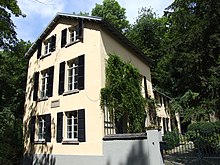Menzenberg

Menzenberg is a south-eastern part of Selhof , a district of Bad Honnef in the Rhein-Sieg district in North Rhine-Westphalia .
geography
Menzenberg is located below the Leyberg ( 359 m above sea level ) on the southeastern edge of the Bad Honnef valley area, although today there is a smooth transition to Selhof on Karl-Simrock-Straße, right on the border with the local community of Rheinbreitbach ( Rhineland-Palatinate ). The place extends largely along the street of the same name on a terrain rising to the east to the Rheinwesterwälder volcanic ridge ( Niederwesterwald ) and includes altitudes between 110 m above sea level. NHN and 145 m above sea level NHN . To the southwest and belonging to Menzenberg is the Hagerhof residential area , which includes Hagerhof Castle with a private high school and the Gut Limpich riding stable .
history
An early documentary mention of the place took place in 1544 as "Meynsberg" and at the same time refers to the former operation of quarries near Menzenberg. In 1678, eight farmsteads were counted in a land measure description of the parish of Honnef in Menzenberg. In 1843 it was listed as a hamlet with 56 inhabitants, in 1885 the Menzenberg residential area had 44 inhabitants in eight residential buildings.
In the 19th century , Karl Simrock , who came from nearby Bonn , owned a winery in Menzenberg and built the "Haus Parzival" (today Menzenberg 9). Wilhelm Grimm , Alexander von Humboldt and above all Ferdinand Freiligrath , who lived in Unkel , six kilometers away , were Simrock's guests in Menzenberg. The philologist Simrock himself used the area for folklore studies and found among other things what he called the “Menzenberger Nachtigall”, the old Mrs. Heinemöhn , who sang old local folk songs for him.
Wine growing in Menzenberg ended at the end of the 1950s. The building of the Simrock winery "Haus Parzival" (Menzenberg 9) still exists today and stands like three other buildings in Menzenberg - the "Weingut Menzenberg" (Menzenberg 12), the former "Villa Coenders" (Menzenberg 6–8) and the building a former Jesuit winery (Menzenberg 11) - a listed building .
Place name
The local chronicler Johann Joseph Brungs (1853-1942) suggested that the name Menzenberg be traced back to the city of Mainz , which could have been home to a monastery or monastery with real estate in the place. Local history researcher Adolf Nekum (1925–2011) followed up on this assumption, but instead connects the place name with local viticulture.
“The field name 'Menzenberg' could not yet be interpreted. (...) The author tends to assume that the name Menzenberg also relates to viticulture. Since the term 'Menserode' appears in old descriptions of the location, and the Siegburg Abbey , the St. Maria Abbey in the Capitol and the Bonn Cassiusstift are mentioned as fiefdoms, it would be possible that the latter benefices (table planks) in the form of wine = Mensae, received from Menzenberg. "
Web links
- Karl Simrock's "House Parzival" in Menzenberg
- History of Menzenberg
- Entry for the winery near Menzenberg in the database " KuLaDig " of the Rhineland Regional Association
- Entry for Weingut Menzenberg 2 in the database " KuLaDig " of the Rhineland Regional Association
Individual evidence
- ^ Adolf Nekum : A thousand years of Selhof, one hundred years of citizens' association , Bad Honnef-Selhof 1988, p. 33.
- ^ Adolf Nekum: A thousand years of Selhof, one hundred years of citizens' association , Bad Honnef-Selhof 1988, p. 38.
- ↑ Royal Government of Cologne (Ed.): Overview of the constituent parts and list of all the localities and individually named properties of the government district of Cologne, according to districts, mayorships and parishes, with information on the number of people and the residential buildings, as well as the Confessions, Jurisdictions , Military and earlier country conditions. Cologne 1845, p. 85 ( digitized version ).
- ^ Community encyclopedia for the province of Rhineland. Based on materials from the census of December 1, 1885 and other official sources, edited by the Royal Statistical Bureau. In: Royal Statistical Bureau (Hrsg.): Community encyclopedia for the Kingdom of Prussia. tape XII , 1888, ZDB -ID 1046036-6 , p. 115 ( digitized version ).
- ↑ Reinhard Zado: Castles, vines and stones , page 82, ISBN 978-3-936256-27-7
- ↑ J [ohann] J [oseph] Brungs : The city of Honnef and its history . Verlag des St. Sebastianus-Schützenverein, Honnef 1925, p. 19 (reprinted 1978 by Löwenburg-Verlag, Bad Honnef).
- ↑ a b Adolf Nekum : Viticulture in Honnef - memories of a 1,100 year history (= Heimat- und Geschichtsverein “Herrschaft Löwenburg” eV : studies on the local history of the city of Bad Honnef am Rhein , issue 10). Bad Honnef 1993, p. 19.
Coordinates: 50 ° 38 ' N , 7 ° 15' E


